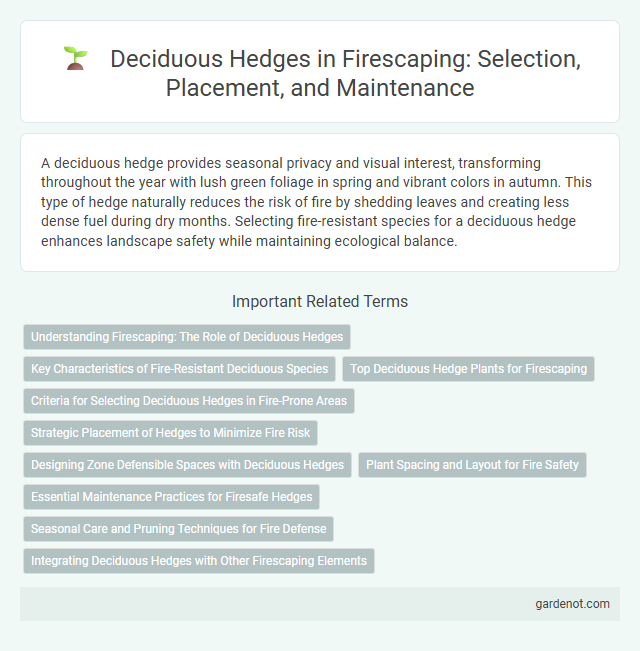A deciduous hedge provides seasonal privacy and visual interest, transforming throughout the year with lush green foliage in spring and vibrant colors in autumn. This type of hedge naturally reduces the risk of fire by shedding leaves and creating less dense fuel during dry months. Selecting fire-resistant species for a deciduous hedge enhances landscape safety while maintaining ecological balance.
Understanding Firescaping: The Role of Deciduous Hedges
Deciduous hedges play a crucial role in firescaping by acting as natural firebreaks that reduce flame intensity and slow fire spread during wildfire events. Their seasonal leaf drop minimizes fuel load in fire-prone seasons, enhancing defensible space around properties without sacrificing privacy or aesthetics. Selecting native, fire-resistant deciduous species ensures effective fire mitigation while supporting local biodiversity and landscape health.
Key Characteristics of Fire-Resistant Deciduous Species
Fire-resistant deciduous hedges typically exhibit high moisture content in their leaves and stems, reducing flammability during peak fire seasons. Species like hawthorn, dogwood, and certain maples possess dense, low-resin foliage and a strong ability to retain water, which help slow fire spread. These hedges also tend to have fewer volatile oils and a more compact growth habit, making them effective natural firebreaks in landscaping.
Top Deciduous Hedge Plants for Firescaping
Top deciduous hedge plants for firescaping include species such as Red Maple (Acer rubrum), American Hornbeam (Carpinus caroliniana), and Eastern Redbud (Cercis canadensis) known for their fire-resistant properties and ability to create effective defensible space. These plants offer high moisture content and low flammability, essential for reducing fire spread around residential areas. Incorporating native deciduous hedges enhances landscape resilience while maintaining aesthetic appeal and ecological benefits in fire-prone regions.
Criteria for Selecting Deciduous Hedges in Fire-Prone Areas
Selecting deciduous hedges for fire-prone areas requires prioritizing species with low resin and oil content to minimize flammability. Plants with high moisture retention, dense but non-combustible foliage, and deep root systems enhance fire resistance and soil stability. Opting for native species adapted to local fire regimes further reduces risk and supports ecosystem resilience.
Strategic Placement of Hedges to Minimize Fire Risk
Deciduous hedges, when strategically placed as firebreaks, significantly reduce fire risk by creating natural barriers that slow down flames and embers. Positioning these hedges between structures and wildland areas interrupts fuel continuity and enhances defensible space around properties. Selecting fire-resistant deciduous species further minimizes combustible material, improving landscape safety during wildfire events.
Designing Zone Defensible Spaces with Deciduous Hedges
Deciduous hedges play a critical role in designing defensible space zones by effectively reducing fire intensity and slowing the spread of flames through seasonal leaf drop and strategic placement. Their ability to create a natural, fire-resistant barrier enhances property protection by separating combustible fuels and maintaining clear, accessible buffer zones. Proper pruning and spacing of these hedges ensure optimal airflow and moisture retention, which further contributes to minimizing fire risk around residential areas.
Plant Spacing and Layout for Fire Safety
Deciduous hedges should be spaced at least 10 feet apart to reduce fire spread risk and create defensible zones. Proper layout involves staggering plant placement to avoid continuous fuel ladders while maintaining adequate airflow for moisture retention. Incorporating fire-resistant species and ensuring regular pruning enhances landscape fire safety by minimizing combustible material accumulation.
Essential Maintenance Practices for Firesafe Hedges
Deciduous hedges require regular pruning to reduce dead wood and maintain manageable branch density, minimizing potential fire fuel. Consistent removal of leaf litter and debris beneath the hedge prevents accumulation of flammable materials. Seasonal watering supports plant health, ensuring less stress and greater fire resistance in fire-prone areas.
Seasonal Care and Pruning Techniques for Fire Defense
Deciduous hedges require seasonal pruning to maintain fire defense by removing dead or damaged branches that can serve as fuel during wildfires. Pruning techniques include thinning to reduce dense foliage and lowering hedge height to create defensible space, which minimizes flame intensity and prevents fire spread. Regular maintenance in late winter or early spring supports healthy growth while enhancing the hedge's ability to act as a firebreak.
Integrating Deciduous Hedges with Other Firescaping Elements
Deciduous hedges enhance firescaping by serving as effective natural firebreaks that reduce flame spread when integrated with gravel pathways, stone mulch, and fire-resistant ground covers. Their seasonal leaf drop helps create fuel layers that require regular maintenance to minimize fire risk alongside strategically spaced, low-flammability plantings. Combining deciduous hedges with ember-resistant barriers and non-combustible hardscaping elements forms a multi-layered defense crucial for protecting properties in wildfire-prone areas.
Deciduous hedge Infographic

 gardenot.com
gardenot.com